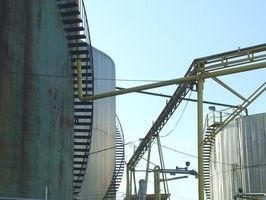Scaffold Ladder Safety

The Consumer Product Safety Commission, or CPSC, reports there are more than 164,000 injuries in the United States annually because of ladder misuse. Scaffolding is generally used in construction projects to help workers reach specific heights. Workers are required to climb the scaffolding via a ladder, which puts them at risk for injuries or death. Following specific safety rules and regulations while on the job can help workers improve chances of staying safe.
OHSA Regulations
The Occupational Safety and Health Administration, or OSHA, requires that scaffolding ladders meet certain requirements. The administration states that ladder-jacks on scaffolding should contain rungs that are a minimum of 10 inches thick. The top of the ladder and each rung must be covered with nonslip material to help increase the safety of workers climbing the scaffold. OSHA further reports that only two men can occupy a ladder on a scaffold at all times.
Types of Injuries
Ladders that are used with scaffolding can be a safety hazard to workers. Bone fractures are the most common injuries sustained when using a ladder, Consumer Affairs says, especially in areas of the body such as hands and feet. More serious injuries that can be sustained include neck and back fractures or breaks caused from falling off of the ladder.
Scaffold Ladder Safety
OSHA urges construction workers to follow general ladder safety regulations when climbing scaffolds. The agency's safe-ladder-climbing policy states that climbers should face the ladder when ascending or descending and never carry items up and down the scaffolding. Climbers should always hold on to the ladder rungs. The top and bottom areas of the ladder should remain free from obstructions and clutter.
Fall Protection
Because scaffolds allow construction workers to complete jobs at extreme heights, certain fall-protection safety devices should be used to decrease workers' chances of injuries and death. When climbing a scaffolding ladder, an anchor, safety harness and lanyard can be used to protect workers from falling. Do not unhook your safety harness from the anchor at any time when climbing up or down the ladder.
Power Lines
Workers atop scaffolding should keep clear of any power lines at all times. The Circle Safety and Health Consultants urge workers to keep the scaffold at least 10 feet away from any power lines. Because scaffolds and their ladders are usually made from steel or aluminum materials, any contact with power lines could cause electrical shocks or electrocutions.
OHSA Regulations
The Occupational Safety and Health Administration, or OSHA, requires that scaffolding ladders meet certain requirements. The administration states that ladder-jacks on scaffolding should contain rungs that are a minimum of 10 inches thick. The top of the ladder and each rung must be covered with nonslip material to help increase the safety of workers climbing the scaffold. OSHA further reports that only two men can occupy a ladder on a scaffold at all times.
Types of Injuries
Ladders that are used with scaffolding can be a safety hazard to workers. Bone fractures are the most common injuries sustained when using a ladder, Consumer Affairs says, especially in areas of the body such as hands and feet. More serious injuries that can be sustained include neck and back fractures or breaks caused from falling off of the ladder.
Scaffold Ladder Safety
OSHA urges construction workers to follow general ladder safety regulations when climbing scaffolds. The agency's safe-ladder-climbing policy states that climbers should face the ladder when ascending or descending and never carry items up and down the scaffolding. Climbers should always hold on to the ladder rungs. The top and bottom areas of the ladder should remain free from obstructions and clutter.
Fall Protection
Because scaffolds allow construction workers to complete jobs at extreme heights, certain fall-protection safety devices should be used to decrease workers' chances of injuries and death. When climbing a scaffolding ladder, an anchor, safety harness and lanyard can be used to protect workers from falling. Do not unhook your safety harness from the anchor at any time when climbing up or down the ladder.
Power Lines
Workers atop scaffolding should keep clear of any power lines at all times. The Circle Safety and Health Consultants urge workers to keep the scaffold at least 10 feet away from any power lines. Because scaffolds and their ladders are usually made from steel or aluminum materials, any contact with power lines could cause electrical shocks or electrocutions.
- 2rbfb1a6d4860607eb94d470d4da7858fc.jpg